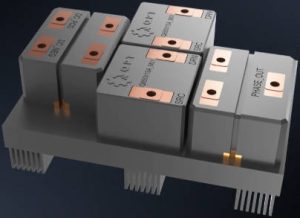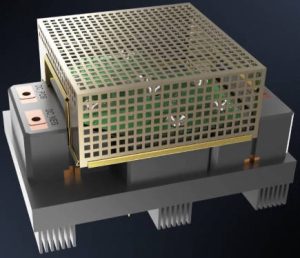Final assembly, EMC screen partially lifted
The alternative is to slow operation until the advantages of GaN fade away, or to risk durability as unseen ultra-fast overshoot and undershoot destroys driver circuits or the switching transistor, company founder and CEO Rob Gwynne told Electronics Weekly.
He argues that it is well worth getting the best out of GaN, because it can reduce the size of a VFD (variable frequency drive) for a 10hp motor, for example, from a 20 litre IGBT design to under a litre for a 2MHz GaN design – small enough to be integrated onto the motor.
Concentrating on single-phase and three-phase hard-switching mains power, QPT has been set up to make modules for GaN-based power supplies that implement all of the RF design, allowing experienced power supply designers to make high-performance GaN-based designs without RF or microwave expertise, and without buying GHz instrumentation. This is analogous to the way that CPU system-on-modules are used to ease the design of digital products.
 Built around multiple patents, three types of module have been developed: an input filter, a transistor+driver module (two-off in the half-bridge assembly left) and an output filter.
Built around multiple patents, three types of module have been developed: an input filter, a transistor+driver module (two-off in the half-bridge assembly left) and an output filter.
Taking the transistor+driver module first, it is an isolated design intended to operate on dc links up to 540V.
With 2MHz switching comes extraordinarily high common-mode transients on the high-side gate driver, particularly as the transistor switches in 1 – 1.5ns in QPT’s design.
“540V switching in 1.5ns will pass though the capacitance of most drive transformers and destroy the driver,” said Gwynne. “Our RF transformer, which we have patented, has immensely low leakage inductance, immeasurably low parasitic capacitance between windings, and can tolerate 600-700V/ns, no problem.”
The switching module is designed to be used in either the high-side or low-side of a half-bridge – so six in a three-phase bridge.
Inside, the 650V power switching transistor is from GaN Systems and the 3GHz GaN pre-driver transistors are from EPC, with many signals travelling over impedance-matched transmission lines.
Much of the support circuitry in the module is implemented in discrete components in this first-generation module – the proof-of-concept as Gwynne describes it – which measures ~30 x 30 x 25mm. Gen2 will shrink this to ~20x20x6mm when an asic, already in the pipeline, mops up many of the separate components.
Propagation delay from input to output is a scorching 3ns – faster than TTL logic, while switching hundreds of volts, “with dispersion measured in picoseconds”, said Gwynne, who added that the dead-band needed between upper and lower PWM inputs is only a few nanoseconds.
As mentioned above, this is for hard-switching PSUs – one of the original promises of GaN is that it can match the high-90s efficiency of complex soft-switching silicon designs at far higher frequencies – and therefore in far smaller enclosures as the inductors and capacitors shrink with increasing frequency.
However, with nanosecond hard switching comes a potentially horrendous EMC problem, which is why QPT is also offering specialist input and output filter modules.
Taking the per-half-bridge output filter as an example, Gwynne’s aim is for it to control all of the frequencies that cannot be dealt with by the experienced silicon PSU designer using conventional Ls and Cs – from GHz down to around 10MHz.
“This is a very fancy microwave power filter,” he said. “It is very special and was hard to design, but its cost per unit in manufacture is low.” It occupies ~1cm3 and needs to be mounted on the ancillary PCB (PCB just visible top image).
The PSU designer will then create the external LC filter that will handle the rest of the EMC (represented by right hand grey box in middle image), passing on the 50/60Hz needed by the motor (or few kHz to a CNC machine motor) – a filter that will be physically small compared with the one in Gwynne’s 25kHz example conventional VFD, due to the GaN VFD’s 2MHz fundamental frequency – and lower cost, he claims.
The modules are intended to be bolted to a heatsink, with ancillary components mounted on a PCB on the other side of the modules (see images). QPT is creating specialist interconnect, as well as design rules for the PCB and the rest of the construction.
The local input reservoir capacitor, from which high frequency current impulses are drawn, are amongst the ancillary components on the interconnect board, to which the OEM will add an external low-frequency reservoir capacitor.
“If they follow our guidelines, they will breeze through EMC with no conducted and no radiated problems,” claimed Gwynne.
Are GaN transistors unreliable?
Much is promised, but GaN transistors are not showing up in real automotive products nor other high-reliability end-products. Are they inherently unreliable?
There is a perception that they are not as reliable, said Gwynne, but this is not based on data.
The technology is not mature, without the history of silicon, or even silicon carbide, he continued, so not enough data is available to come to a firm conclusion.
Something that might be contributing to the perception is those ultra-fast overshoot and undershoot spikes, outside device specification, that are easily generated, but not easily seen, and certainly not accurately measured without the right instruments and the correct probing technique.
QPT was founded in 2019, “after 10 years of development work, said Gwynne, and is headquartered in Cambridge UK. It has R&D and production Portugal, and production engineering and a lab in Poland. The production line has been set-up to take Gen2 products to around 100,000 units, after which assembly houses are being considered.

